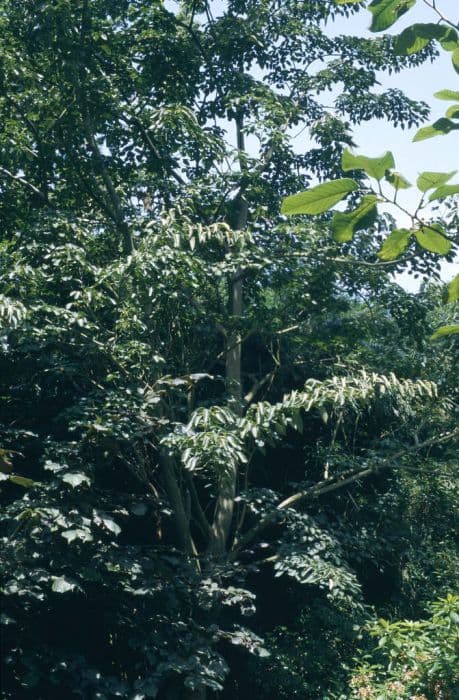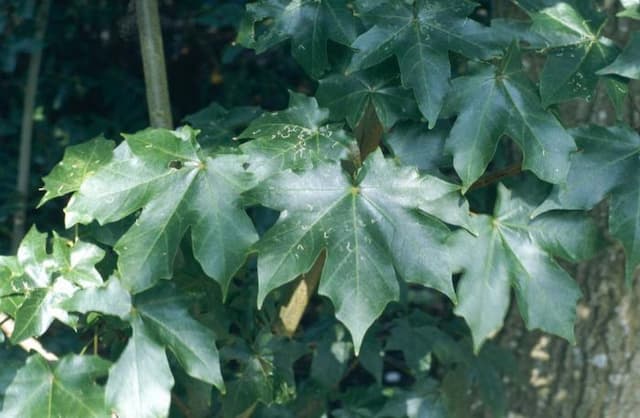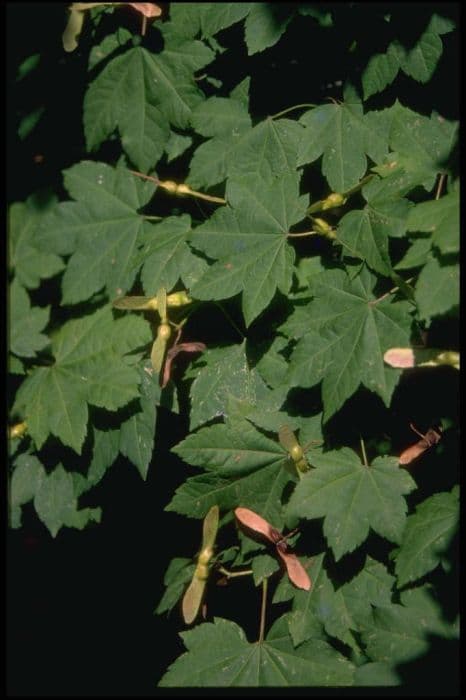Japanese Maple Acer palmatum 'Orange Dream' (P)

ABOUT
Japanese Maple 'Orange Dream' features a truly striking appearance characterized by its unique foliage and stunning coloration. The leaves of this ornamental tree exhibit a diverse palette throughout the seasons. In spring, the foliage emerges with a vivid orange tone that gently transitions into a bright, yellow-green as the leaves fully open. Each leaf comprises multiple lobes, radiating out like the palm of a hand with pointed tips, which provides a delicate and lacey visual texture. As autumn approaches, the leaves transform once again, this time into a kaleidoscope of colors ranging from fiery oranges to soft yellows, creating an eye-catching display in any garden. The bark of the 'Orange Dream' is smooth, providing a subtle backdrop that allows the brilliant foliage to take center stage. Overall, the plant exudes an aura of elegance and serenity, making it a highly desirable addition for those seeking to add a touch of color and refined beauty to their outdoor spaces.
About this plant
 Names
NamesFamily
Sapindaceae.
Synonyms
Japanese Maple, Smooth Japanese Maple.
Common names
Acer palmatum 'Orange Dream'.
 Toxicity
ToxicityTo humans
The Japanese Maple is generally considered non-toxic to humans. There are no well-documented cases of poisoning from ingesting parts of this plant. However, as with any plant, individual allergies or sensitivities could cause adverse reactions in some people.
To pets
The Japanese Maple is also generally considered non-toxic to pets, including dogs and cats. It is not known to cause poisoning if pets ingest its leaves or seeds. However, it is always wise to prevent your pets from eating plants as a precautionary measure, and to monitor for any signs of illness if they do consume any plant material.
 Characteristics
CharacteristicsLife cycle
Perennials
Foliage type
Deciduous
Color of leaves
Mixed
Height
10 feet (3 meters)
Spread
8 feet (2.4 meters)
Plant type
Tree
Hardiness zones
5
Native area
Japan
Benefits
 General Benefits
General Benefits- Ornamental Value: This Japanese Maple cultivar is prized for its beautiful foliage, with leaves turning from a bright orange in spring to yellow-green in summer and then to a vibrant orange-yellow in the fall.
- Size Appropriate for Small Gardens: Acer palmatum 'Orange Dream' has a compact growth habit, making it suitable for smaller gardens or spaces with limited room.
- Shade Tolerance: It can tolerate partial shade, giving gardeners more options for planting in different garden aspects.
- Seasonal Interest: This tree offers visual interest across multiple seasons with its changing leaf colors and delicate structure.
- Low Maintenance: Once established, it requires minimal care, only needing occasional pruning to maintain desired shape and health.
- Attracts Wildlife: The tree can attract birds and butterflies, adding to the biodiversity of the garden.
- Provides Privacy: When planted in groups, Japanese Maples can create a screen that offers some privacy while still being aesthetically pleasing.
- Container Planting: Suitable for growing in containers, it is an ideal choice for patios and decks.
- Improved Microclimate: The canopy can offer a cooler microclimate in hot summers and some protection from harsh weather for underplantings.
- Cultural Significance: Japanese Maples are often associated with peace and serenity, and can contribute to a calming atmosphere in the garden.
 Medical Properties
Medical PropertiesThis plant is not used for medical purposes.
 Air-purifying Qualities
Air-purifying QualitiesThis plant is not specifically known for air purifying qualities.
 Other Uses
Other Uses- Acer palmatum 'Orange Dream', commonly known as Japanese maple, can be used in bonsai cultivation for creating miniature landscapes due to its small leaves and attractive branching patterns.
- The leaves of the Japanese maple can be pressed and preserved to create botanical art, taking advantage of their vibrant orange and red hues during the fall season.
- Japanese maple wood, though not commonly used due to the tree's small size, can be crafted into fine woodworking projects such as jewelry boxes or picture frames.
- The striking colors of Japanese maple can be part of a sensory garden, especially designed for visual stimulation to soothe and uplift visitors.
- Japanese maple branches can be incorporated into floral arrangements or used as a natural base for mounting air plants or orchids.
- In photography, Japanese maple trees can serve as a serene backdrop for portraiture or as a subject for nature photography, particularly during autumn.
- Ceremonial spaces such as tea gardens or meditation areas often utilize Japanese maple trees for their serene and contemplative aesthetic.
- Leaves from the Japanese maple can be used in crafting, such as making autumn-themed garlands or incorporated into handmade paper.
- Japanese maple can be installed as part of a living fence or privacy screen, with its dense foliage providing seclusion and beauty.
- The tree can be strategically planted in a garden to provide shade for shade-loving plants, as its canopy allows filtered sunlight to pass through.
Interesting Facts
 Feng Shui
Feng ShuiThe Japanese Maple is not used in Feng Shui practice.
 Zodiac Sign Compitability
Zodiac Sign CompitabilityThe Japanese Maple is not used in astrology practice.
 Plant Symbolism
Plant Symbolism- Beauty in Change: Representing the 'Orange Dream' Japanese Maple, this symbolism reflects the plant’s vivid color transformation through seasons, displaying the elegance of nature's cycles.
- Peace and Tranquility: The serene growth habit and graceful structure of the Japanese Maple are often seen as embodying a quiet, peaceful existence.
- Balance: With its harmonious canopy and branched symmetry, the Japanese Maple symbolizes balance in life, encouraging a sense of calm and equilibrium.
- Endurance and Strength: Despite its delicate appearance, the Japanese Maple is a hardy species, symbolizing the ability to withstand challenges and remain strong.
 Water
WaterFor the Japanese Maple 'Orange Dream,' water it deeply once a week during the growing season, ensuring you use about 10-20 gallons depending on the size of the tree and the weather conditions. During hot or windy periods, you may need to water more frequently, while in cooler or rainy periods, you can water less. Watering should be done in the morning or evening to minimize evaporation. Make sure the soil has good drainage to prevent water logging, which this maple does not tolerate well. Adjust the watering during the winter months when the tree is dormant, reducing the frequency to only when the soil is dry to the touch.
 Light
LightJapanese Maple 'Orange Dream' prefers a spot with partial shade to full sun exposure. It thrives best when it receives morning sunlight and is protected from the intense afternoon sun, especially in hotter climates. Ideal planting locations include eastern exposures or dappled shade under larger trees that can provide protection from harsh sun rays.
 Temperature
TemperatureJapanese Maple 'Orange Dream' is hardy in temperatures as low as -10 to -20 degrees Fahrenheit, but the ideal temperature range for this plant is between 60 to 80 degrees Fahrenheit. It can withstand brief periods of higher temperatures, but prolonged heat can cause stress. The plant should be protected from extreme winter cold and harsh winds.
 Pruning
PruningPrune the Japanese Maple 'Orange Dream' to maintain its health and desired shape, removing dead or damaged branches and any limbs that disrupt the tree's natural form. The best time to prune is late winter just before spring growth starts. Pruning is typically only needed once per year, but can be done more frequently if the tree is actively grown in a particular shape or design.
 Cleaning
CleaningAs needed
 Soil
SoilJapanese Maple 'Orange Dream' thrives in well-draining, slightly acidic soil with a pH of 5.5 to 6.5. A mix of 1/3 peat moss, 1/3 pine bark, and 1/3 coarse sand or perlite is ideal for promoting root health and preventing waterlogging.
 Repotting
RepottingJapanese Maples like 'Orange Dream' typically need repotting every 2-3 years. They should be repotted in spring before new leaves emerge, using a well-draining soil mix while being careful not to disturb the delicate roots too much.
 Humidity & Misting
Humidity & MistingJapanese Maple 'Orange Dream' prefers moderate humidity levels, but it's adaptable and can tolerate the varying humidity levels typical of outdoor environments. No special humidity adjustments are needed indoors if the leaves are kept from drying winds.
 Suitable locations
Suitable locationsIndoor
Place 'Orange Dream' in bright, indirect light with ample airflow.
Outdoor
Plant 'Orange Dream' in partial shade and protect from strong winds.
Hardiness zone
5-9 USDA
 Life cycle
Life cycle'Orange Dream' Japanese Maple, an ornamental shrub or small tree, begins its life as a seed which after stratification germinates in spring. Once the seedling emerges, it enters a juvenile growth phase, developing its characteristic palmate leaves and establishing a root system. As it matures, the plant enters a vegetative state where it continues to grow in size and foliage density, exhibiting its vibrant orange to yellow-green spring foliage that turns green by summer and golden-yellow with hints of orange and red in fall. Upon reaching maturity, after several years, it produces small purple flowers which are followed by samaras (winged seeds) that disperse by wind. 'Orange Dream' enters a period of dormancy during winter, when the leaves fall, and it conserves energy until the next growth cycle in spring. Throughout its life, which can span over several decades if conditions are favorable, this ornamental tree requires well-drained soil, partial to full sun, and protection from strong winds to thrive.
 Propogation
PropogationPropogation time
Early spring
The most popular method of propagating the Japanese Maple 'Orange Dream' is through softwood cuttings. This technique is typically done in early summer when new growth is still soft and flexible. Cuttings about 4 to 6 inches (10 to 15 cm) long are taken from the current year's growth and the leaves at the lower end are removed. The cut end of the cutting is then dipped in a rooting hormone to encourage root development and planted in a well-draining soil mix. The container with the cutting should be kept in a humid environment with indirect light and a consistent temperature to promote rooting, which can take several weeks. Once rooted, the cuttings can be transplanted into individual pots to grow on before being planted out in the garden.





![Freeman maple [Autumn Blaze]](/_next/image?url=https%3A%2F%2Fplants-admin.emdemapps.com%2Fimages%2Fplants%2F%2Fimages%2F604b575b84d87.png&w=640&q=75)



